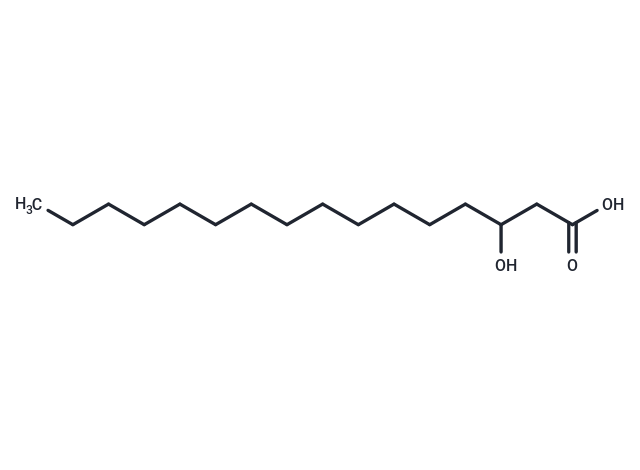 Your shopping cart is currently empty
Your shopping cart is currently empty

3-hydroxy Palmitic acid is a form of the 16:0 lipid palmitic acid . The lipid A part of lipopolysaccharides contain various 3-hydroxy fatty acids, making oxylipins such as 3-hydroxy palmitic acid useful as chemical markers of endotoxins. In R. solanacearum, 3-hydroxy palmitic acid is converted by an S-adenosyl methionine-dependent methyltransferase to 3-hydroxy palmitic acid methyl ester, which acts as a quorum sensing signal molecule for post-transcriptional modulation of genes involved in virulence. Long-chain 3-hydroxy fatty acids, such as 3-hydroxy palmitic acid, are also known to accumulate during long-chain 3-hydroxy-acyl-CoA dehydrogenase and mitochondrial trifunctional protein deficiencies. Such accumulation induces oxidative stress, leading to mitochondrial bioenergetics deregulation and eventual multi-organ dysfunction.

| Pack Size | Price | USA Warehouse | Global Warehouse | Quantity |
|---|---|---|---|---|
| 50 mg | $337 | 35 days | 35 days | |
| 100 mg | $589 | 35 days | 35 days | |
| 250 mg | $1,390 | 35 days | 35 days | |
| 1 g | $4,290 | 35 days | 35 days |
| Description | 3-hydroxy Palmitic acid is a form of the 16:0 lipid palmitic acid . The lipid A part of lipopolysaccharides contain various 3-hydroxy fatty acids, making oxylipins such as 3-hydroxy palmitic acid useful as chemical markers of endotoxins. In R. solanacearum, 3-hydroxy palmitic acid is converted by an S-adenosyl methionine-dependent methyltransferase to 3-hydroxy palmitic acid methyl ester, which acts as a quorum sensing signal molecule for post-transcriptional modulation of genes involved in virulence. Long-chain 3-hydroxy fatty acids, such as 3-hydroxy palmitic acid, are also known to accumulate during long-chain 3-hydroxy-acyl-CoA dehydrogenase and mitochondrial trifunctional protein deficiencies. Such accumulation induces oxidative stress, leading to mitochondrial bioenergetics deregulation and eventual multi-organ dysfunction. |
| Molecular Weight | 272.42 |
| Formula | C16H32O3 |
| Cas No. | 2398-34-7 |
| Storage | Powder: -20°C for 3 years | In solvent: -80°C for 1 year | Shipping with blue ice/Shipping at ambient temperature. | ||||||||||||||||||||||||||||||
| Solubility Information | DMSO:PBS(pH 7.2) (1:2): 0.33 mg/mL (1.21 mM), Sonication is recommended. Ethanol: 2.5 mg/mL (9.18 mM), Sonication is recommended. DMSO: 20 mg/mL (73.42 mM), Sonication is recommended. DMF: 20 mg/mL (73.42 mM), Sonication is recommended. | ||||||||||||||||||||||||||||||
| In Vivo Formulation | 10% DMSO+90% Corn Oil: 2 mg/mL (7.34 mM), Sonication is recommeded. Please add the solvents sequentially, clarifying the solution as much as possible before adding the next one. Dissolve by heating and/or sonication if necessary. Working solution is recommended to be prepared and used immediately. The formulation provided above is for reference purposes only. In vivo formulations may vary and should be modified based on specific experimental conditions. | ||||||||||||||||||||||||||||||
Solution Preparation Table | |||||||||||||||||||||||||||||||
Ethanol/DMSO/DMF
DMSO/DMF
| |||||||||||||||||||||||||||||||
| Size | Quantity | Unit Price | Amount | Operation |
|---|

Copyright © 2015-2025 TargetMol Chemicals Inc. All Rights Reserved.